Lantana: description, types and flower care at home

The presence of green plants in the house, apartment and even in office premises creates coziness and significantly improves mood. Blooming specimens are especially pleasing. Their flowers, different in shape, size and color of petals, give aesthetic pleasure, and some species also exude a delicate pleasant aroma. Lantana also belongs to such plants.

Peculiarities
Features The description of the genus Lantana (Lantana), which received its name thanks to the Swedish naturalist Karl Linnaeus, comes down to a systematic classification. This perennial belongs to the Verbenaceae family. Wild species, and there are many of them at the moment (from 140-170), mainly grow in the territories of Central and South America, and for some species the habitat is Africa and Southeast Asia.


In some countries, lantana is not favored and is even forbidden to grow, as it displaces the flora adjacent to it. Lantana is an intensively branching shrub that, in natural conditions, reaches a 3-meter mark in a very short time. And this is not surprising, because it has a rather powerful and well-developed root system, growing not only in depth, but also in width.
Its flexible, fast-growing stems with a compacted upper layer are light green in color; in some species, thorns are present on the surface of the shoots. Short-petiolized leaves with a predominantly green color are located on the stems opposite each other or in a spiral order. The leaf blade is small (4–5 cm), predominantly oval in shape with a serrated edge and clearly defined veins, very similar in appearance to a nettle leaf. In most species, the leaves are tough, with a rough surface to the touch, but there are varieties with smooth leaves.

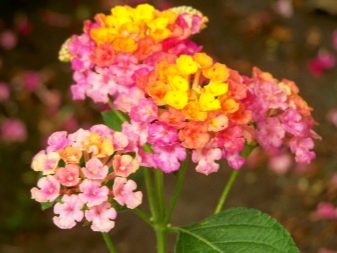
The plant has a rather long and beautiful flowering. The flowers are small, the corolla diameter does not exceed, as a rule, 4–5 cm, collected in inflorescences. In wild-growing forms, in one inflorescence, flowers with different colors of petals can be observed. White, yellow, orange and scarlet flowers on their thin pedicels are quite tightly adjacent to each other, forming a very beautiful multi-colored ball. The variety in the color of the petals is associated with the degree of maturity of each flower: the more time passes from the day the bud is dissolved, the darker the petals acquire.


In their natural habitat, after the end of flowering, in place of the flowers, two-seeded green berries of a round shape are formed. Unripe fruits contain a fairly large amount of a toxin that is dangerous for humans and animals, but as they ripen, the threat of poisoning decreases, and the fully ripe fruit is even used as an additive to dessert dishes.
Lantana is famous not only for its color-changing petals, but also for the specific aroma emanating from the leaves of the plant. From the slightest contact, the glands located on the surface of the leaf plate are triggered, and the surrounding space is immediately filled with a spicy aroma. Not everyone will like this aroma, because in addition to the pleasant notes of lemon and mint, it also contains the smell of camphor and the subtle aroma of onions.


Varieties
Cultivating wild species is not an easy task, and it takes a lot of time for a plant to get the necessary traits.Despite the fact that the genus lanthanum has many species, few were suitable for breeding. One of these species is spiny lantana. Also, this type of perennial shrub, reaching a height of one and a half meter in nature, is called vaulted lantana or camara (Lantana camara). Thorny lantana got its name not by accident: its erect shoots with a lignified top layer are completely covered with small thorns. The foliage is colored deep green. The leaf plate with small denticles along the edge has an ovoid shape, in which the outer tip is slightly pointed. The front side of the plate is rough to the touch, and the inner side, hidden from the eyes, is covered with soft whitish "villi".

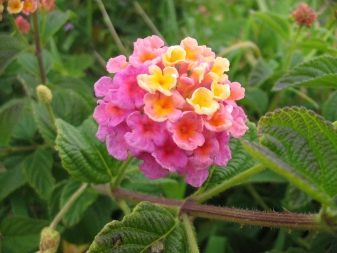
The plant is characterized by a paniculate type of inflorescence. The diameter of the corolla in flowers is no more than 5 cm. During the flowering period, which lasts from May to October, the plant forms beautiful lush "balls" of flowers of different colors. At first, buds appear with yellow or pink petals, and only over time, the color of the petals changes to orange, and then to red. The ripe berries formed after the petals fall off have a blue-black color.


The cultivar "Lyubava" is created on the basis of vaulted lantana. Its main characteristics are not much different from its progenitor. Green stems strewn with thorns, faceted on 4 sides, oval leaves with a greenish-gray tint, and medium-sized flowers that form inflorescences-balls. During the flowering period, the color of the petals changes from orange to pink or scarlet. Some breeders have bred hybrids with monochrome inflorescences. For the variety "Samantha" the character is lemon-yellow color of the inflorescences, and for the hybrid "Golden Apple" the flowers have a bright golden hue. White color of flowers with a slight accent in the form of a small yellow speck in the center is characteristic of the variety with the beautiful name "Naida".


Montevidean lantana (Lantana montevidensis) is somewhat different from Camara. The stems of this species are flexible and curly, and the lignification of the upper layer is observed only closer to the base. Ovate leaf plates are slightly smaller than those of the prickly species of lantana, their length does not exceed 3 cm. The flowers are smaller in comparison with the camara, the corolla diameter is within 2–3 cm, collected in spherical inflorescences, in which purple lilac and pink tones. Flowers with yellow or white color are much less common.


Variegated lantana (Lantana variegata), in contrast to the previous species, has a slightly different leaf color. Its leaf plates are variegated: pale green, whitish and silvery specks are scattered in a chaotic manner over the entire surface. To obtain such changes in the color of foliage, plants of this species undergo artificial modifications, which almost always affects the resistance of the species, which means that the resulting hybrids will be more demanding in care.


Conditions of detention
For good growth and development of the plant, it is necessary to create the appropriate conditions. Components of an optimal microclimate: temperature, humidity, lighting, soil composition. The temperature of the surrounding space is a rather important indicator for a plant; it affects not only growth, but also the duration of flowering. The year from the life cycle of lantana is conventionally divided into 3 periods: summer (active), autumn-spring (preparatory), winter (dormant period).


There are optimal indicators for each period. For summer, the optimal performance should be within + 22-27? C. During the preparatory period, especially when the plant is preparing for enhanced growth, the temperature should not go beyond + 14-18C. Well, during the dormant period, the plant will calmly withstand temperatures from +5 to +12? C. Lighting is an equally important indicator.The tropical beauty lantana belongs to light-loving plants, which means that good lighting is a blessing for her. It is permissible to keep the plant in direct sunlight, but no more than 3-5 hours during the daytime. In winter, the plant needs lighting.


The optimum moisture content for lanthanum is 40-50%. During the active period, frequent watering and spraying is carried out; during the preparatory season, the frequency of watering should be reduced.
The soil also plays an important role in the plant's life cycle. The main indicator here is the acid-base balance (pH). For lanthanum, the optimal indicator is 7. Small fluctuations are allowed within the range of 6.6–7.

Transfer
Lantana is a fast growing plant, so it needs to be replanted every year. It is best to do this procedure in the spring, before the plant grows. If the variety is intended for growing at home or is a tub culture, then the planting capacity should be slightly larger than the previous one. And if the culture is intended for growing in open ground, then the soil is simply dug up and loosened.


It is necessary to transplant indoor and tub crops carefully; the transshipment method is the most gentle for the plant. It is not always possible to completely change the pot, so you only have to change the top layer. It is enough to remove a layer of 7 cm and fill the voids with fresh substrate. Transplant soil can be purchased at the store, any universal one for flowering plants is suitable, but you can also prepare it yourself. Mix 4 parts of leafy earth with 2 parts of fertile turf and add 1 part of humus and fine river sand to the mixture.


How to care?
Despite the fact that wild species of lantana grow in rather specific conditions, indoor and tub crops quite easily adapt to both home and garden content. The rules of care are not so complicated as to refuse the content of lantana, the main thing is to observe some precautions. At home, lantana will feel good near windows facing the south, southeast, southwest sides. In the hot season - if at night the temperature does not drop below + 18–20C - you can take it out to the balcony, loggia, veranda and even to the garden. The main condition for placement is the absence of drafts. The constant supply of fresh air encourages the growth of shoots and lush blooms.

Watering should be abundant and regular. Do not allow both excessive drying of the soil and excessive overflow. Lack of moisture can lead to the discharge of foliage, and its excess can lead to decay of the roots. In the active period of growth and flowering, lanthanum needs spraying, but this must be done extremely carefully, to ensure that water does not fall on the inflorescences. To maintain optimal humidity, you can install a container with a flower in a special tray with wet expanded clay.

In the spring-summer period, lantana must be fed and this must be done at least once every two weeks, but not more often, otherwise, instead of lush flowering, shoots will grow vigorously. You can use any universal fertilizer for houseplants, but the single dose of the drug should be reduced by 2 times. In the preparatory period, you can feed the plant with your own prepared fertilizer, which is based on cow dung mixed with water in a ratio of 1: 14. In winter, when the plant is in a dormant period, you do not need to apply additional fertilizing.

Plant pruning must be carried out during the preparatory period. The old side stems are cut off, which remained in the lower part without foliage. On the rest of the shoots, the pinching procedure is carried out - it is enough to remove the 2 upper buds and the enhanced development of young lateral shoots is ensured, and with them a lush flowering.With the help of pruning, you can give the crown of lantana almost any shape and grow not only a healthy plant, but also an aesthetically attractive one.

Reproduction
For lantana, only two methods of reproduction are possible: cuttings and seeds. Less time consuming and more realistic, of course, is cuttings. In order to properly propagate lantana, it is necessary to choose the right material, which are young shoots with a thin, slightly lignified top layer. Having outlined suitable shoots, cut off the cuttings - their length should not exceed 10-12 cm - and leave them for 3 hours for airing. We prepare the container and fill it with already moistened peat, perlite or vermiculite. We make a small depression (2-3 cm) in the prepared soil. In order to properly root the cuttings, it is necessary to remove the foliage from the lower part.
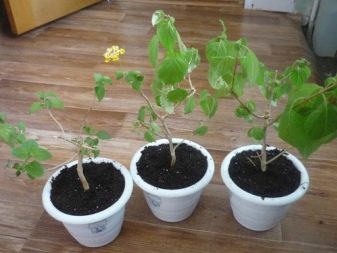

After the shoot has been planted, we proceed to create conditions. In order for the escape to give roots, you need to cover it from above, create a greenhouse. You can cover with a plastic bottle, glass jar, or use a plastic bag for this process. In the first week, the temperature inside the greenhouse should be within + 20C, then it can be reduced to + 15C. Good rooting will not work without bright, but diffused light for 12 hours, constant humidification with a spray bottle and regular ventilation. After the cuttings begin to grow, the covering material must be removed. In order for the cuttings to grow not only in height, but also to give lateral shoots, they are pinched. This should be done regularly, at least once every 2 months.

It is somewhat more difficult to propagate lantana by seeds than by cuttings: a very low survival rate of seedlings, therefore, the method is rarely used at home.
Diseases and pests
Lantana, like most plants, is susceptible to a wide variety of diseases. As a rule, their occurrence is associated with improper care. Diseases such as root rot, gray rot, rust and brown spot are fungal in nature, therefore, various types of fungicides are used in the fight against them. Signs of root rot: the formation of black spots at the base of the shoot and leaf plates, the surface of the soil is covered with mold colonies, from which a specific smell emanates (a mixture of carbon dioxide with essential oils). Having previously cleaned the roots from the soil and soaked them in a fungicide solution (2%), the plant is transplanted completely, replacing the substrate and disinfecting the pot. Close observation is carried out for 3 months.


Signs of gray mold: the formation of spots of beige color on the foliage with a characteristic grayish bloom, against the background of which microscopic dotted blotches are visible. Getting rid of rot is possible only if the affected foliage is removed and the lanthanum and soil are sprayed with preparations such as Horus, Teldor or Tsineb. Within 3 months, the plant is sprayed using "Fundazol", "Baylon" or "Topsin", having previously prepared a 0.1% solution from the selected product.
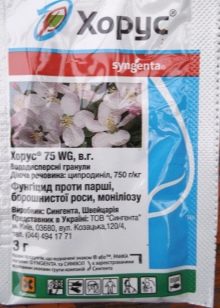
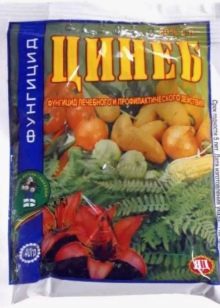

Rust, with its characteristic yellowish-orange spots on the inside of the foliage, can be destroyed by spraying the plant. For this, a 1% solution is prepared from such a drug as "Baktofit". The affected leaves are removed. Re-spraying is carried out in two weeks. Brown spot is characterized by specks with a light olive color.located on the front side of the plate. Over time, brown spots form on the inside, and the leaves begin to turn yellow. The plant can be cured with the help of drugs such as Vectra or Fitosporin. The procedure must be repeated at least 2 times after 7 or 10 days.
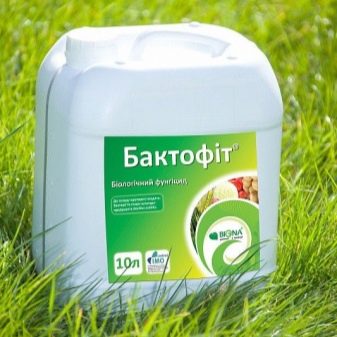

When affected by aphids and mealy worms, foliage and shoots are treated with soapy water, and then washed well with lanthanum in the shower. When repeated signs appear, the plant is treated with insecticides.You can use a fumigator or duct tape to fight whitefly. The pests are collected with a vacuum cleaner, and the plant is sprayed using an infusion, in which the main components are mustard powder, pepper and tobacco chips.

For information on how to properly care for lantana at home, see the next video.































































































The comment was sent successfully.